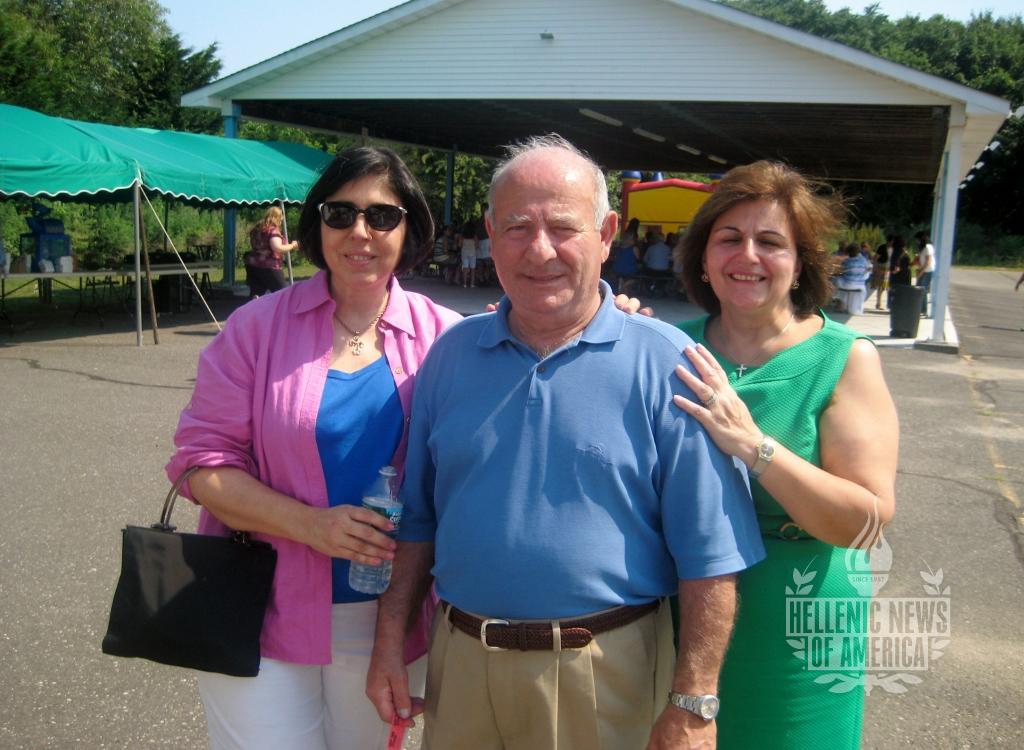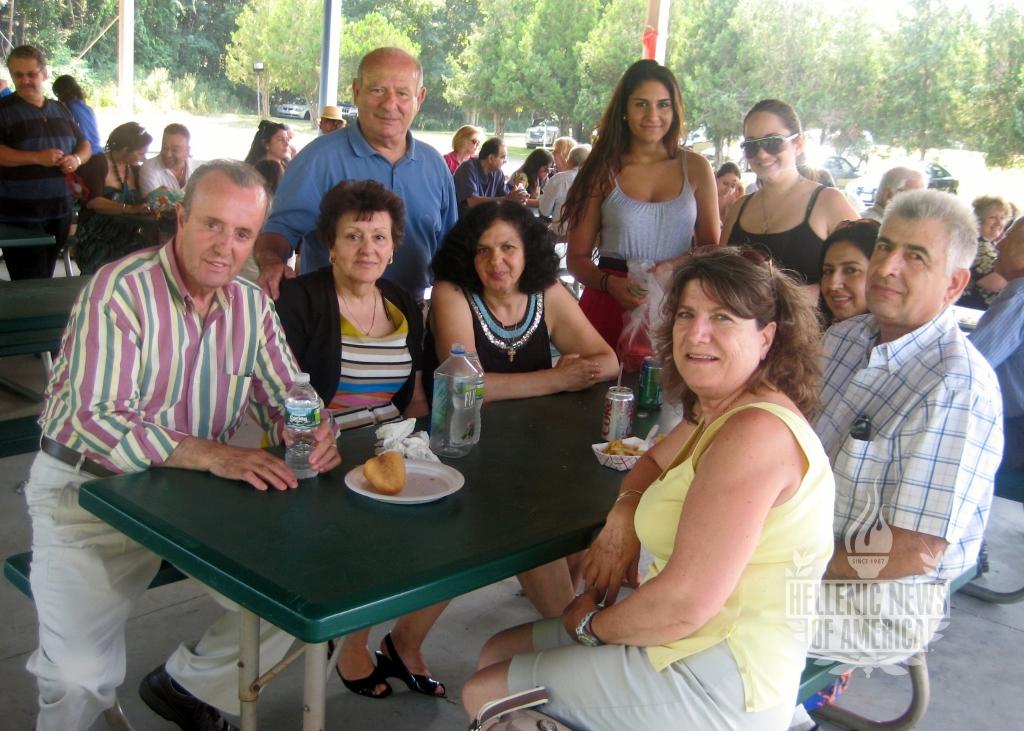Kambia: Profile of a Chios Village and Society
By Catherine Tsounis
Summer is a time of reunions in the East End of Long Island. Queens’s residents travel to Mattituck to enjoy the sea breezes. The Kambia Society of Chios recently had an outdoor barbecue picnic on Sunday, July 2nd at the Transfiguration of Christ Church on Breakwater Road in Mattituck. Traditional and Modern Greek music was played. Member and guests renewed family and cultural bonds. The town’s traditions are kept alive by Greek-Americans from Astoria, Whitestone, Bayside, Flushing, New York and the tri-state area. The Society is a member of the Chian Federation located in Astoria, New York.
The officers are the following persons: John Mihalios, President; Lambros Zoumas, Secretary; Lambros Giamboulis, Treasurer; Diodoros Mihalios, Lefteris Kaloudis, John Mihalios, Teddy and Demetri Mihalios, Bill Zoumas and Lambros Koutsouros, Board Memebers; Sophia Gatanas, Demetrios Mihalios, Lily Mihalios; Evangelia Kaloudis, Nikolaos Kaloudis, Emma Maletakis, Irene Mihalios, Kellie Mihalios, Sophia Mihalios, Maria Mihalios, Katie Maletakis, Sophia Maletakis, Despina Mihalios Kalogeras, Avgoustis Psarros, Michael Psarros and others.
A vibrant youth presence was seen in the “Youth of Kambia”. The officers include: John Mihalios, President; Nick Sideras, Vice-President; Maria Zoumas, Treasurer; Kalliope Koutsoumbis, Assistant Treasurer; Maria Mihalios, Secretary; Jimmy Koutsoubis, Assistant Secretary; Sophia Axiotis, Markella Axiotis and Peter Sideras, Board Members.
President John Mihalios is a Greek-American youth fluent in Greek. “We started the Kambia Youth Society four years ago,” he said. “We are trying to keep our culture and traditions alive. We hold a dance every year. Three hundred youth attended. Everyone goes back to Kambia in the summer. It is gratifying when our social events go well. We feel we are a community that remembers our Greek roots.”
Nicholas Kaloudis, a former student of our Modern Greek University classes, said he “was from Kambia, Chios.” An outstanding scholar and winner of numerous scholarships, Kaloudis is in the Physician Assistants Program at New York Institute of Technology. Evangelia Kaloudis, his mother, explained “my late husband, Chris, was from Kambia. We keep our family ties strong by being part of the Kambia Society.”
Kambia is a small village at the northern part of Chios. It lies at the foothill of the Pelinneon Mountain, the tallest in Chios. One looks down and sees the Mediterranean Sea and the coast of Tseme, Turkey. Cherry and chestnut trees with olive groves are abundant. The Fortress of Kambia (or Fortress of Orias) is the main tourist attraction. The Genoese were in control of the town and island from 1261-1566. Then, it became part of the Ottoman Empire until 1912. In June, Kambia holds an annual Cherry Festival or “Yiorti ton Kerrasion”. The town holds several festivals during the summer months.
“Our village is ancient with two castles at Kastilli and Agia Paraskevi,” said Michael Psarros. “A historic battle took place with Venetians, Genoese and Saracens. Gold is hidden in the grounds. The government prohibits digging on these sites.” Avgoustis and Michael Psarros have a unique interest in preserving their town’s history. Sophia Gatanas, a professional in the Steven Papadatos architectural firm, gave a warm greeting to all at the picnic. “My godson is Kostas Koutsoubis, a physical therapist at NYPT in Flushing by St. Nicholas Greek Orthodox Church.” Everyone from Chios is interconnected.
Demetrios Mihalios and his late wife Sophia are members of the Transfiguration church, Mattituck and a local Queens church. “I left Kambia in 1960 by entering the merchant marine. When we landed in New York City, I left and married Sophia who was from Kambia. I was a painter for many years. Today three generations of my family are at the reunion.” The late Sophia Mihalios was a driving force in the Ladies Philoptohos Society of the Mattituck Church. Their daughter, Kellie Mihalios is an outstanding professional in the Home Mortgage industry.
Rev. Constantine Makrinos, presbyter (priest) of the Transfiguration Church said “I am from Kardamyla. I am pleased to be at this social in a town where Greek traditions are kept and handed down from one generation to the next.” There are social and economic differences in the infrastructure of the southern and northern parts of Chios. In the “Voreiochora” (northern parts), residents are involved in animal farming. From the 18th-19th century onwards, many turned to shipping, especially in north-eastern Chios. Shipping is centered in Kardamyla and the neighboring island of Oinousses.
“I enjoy singing the songs of Kazantzides with my brother-in law Elias Liakaris,” said Lefteris Kaloudis. Kambia in 1950 was the largest village in Northern Chios with about 1300 persons. Now there are only 40 persons all year round.” President Mihalios added that “in the summer it’s difficult to park your car, because of so many people returning to the village. On September 8th, a special event is held at our Church of Panagia Despina.
“We have a slow tsifteteli and syrtos,” said President John Mihalios and his brother Demetrios. “We hold on to the ancient civilization of Smyrna that has vanished. When we have weddings at Panagia Despina Church, everyone in neighboring villages is invited. Our weddings are like those held in Constantinople. Two hours of continuous dancing with everyone having the opportunity to dance with the bride.”
The Erythraia Peninsula opposite Chios was to epitomize the preservation of modular musical tradition…as the four beat ballos, four beat tsifteteli, seven beat kalamatianos and 9 beat zeibekiko,” said the Heraklion Alatsata Association in the CD album “Blow in, breeze from Asia Minor.” These beats are heard in Kambia’s music. Old narrative songs of Greece and Asia Minor are played in Chios. The musical culture of Asia Minor was influential, especially following the destruction of Asia Minor in 1922 and the permanent resettlement of refugees in the town of Chios. The old tunes of syrtos, zeibekiko and tsifteteli are played at gatherings such as the Kambia reunion picnic.
Demetrios Mihalios and Despina M. Kalogeras said a phrase spoken by Chiotes for years. “Tseme is opposite us. We see the lights of Tseme”, referring to the coast of Asia Minor, Turkey. Modern day Tseme is a province that is part of the prefecture of Izmir (Smyrna). Prefecture is similar to the states of New York or New Jersey. A county such as Queens, Nassau, Suffolk are considered provinces. Chios, Samos and Tseme were part of a civilization known as Ionia that encompassed the western coast of Asia Minor on the Aegean Sea. To the Ancient World, the Ionians were one of many Greek tribes. To the Asians, the Ionians were all the Greeks who are called Giounan (Giounan) today. Such was the power and radiance of the Greek cities.
They overshadowed every other Greek presence in the East. According to Herodotus, the Greek Ionian cities included: Phocaea, Clazomenae and Erythrae (part of Tseme) in the north; Colophon, Teos, Lebedus and Ephesus in the center; Miletus, Myus and Priene in the south and the islands of Chios and Samos. The heart of Ionia was opposite Samos at Ephesus, Miletus and Priene. They formed an Ionic league that held joint festivals and athletic competitions. The colonies were economically strong but strategically weak. The area occupied was 90 miles long and 30 miles deep. The seaports of Ionia flourished from 8th century B.C. until the Turkish conquest of the 15th century A.D.
The Ionians, according to tradition, fled to Asia Minor from Greeceʼs mainland to escape the invading Dorians. Athens claimed to be the Mother City of all Ionian colonists. Modern scholars believe the Ionians were a mixed group from Attica and Boeotia (modern day Evia). After their immigration, they further mixed by intermarriage with native groups such as the Carians. Nevertheless, they spoke the Greek dialect spoken in Attica and Euboea. Their Greek dialect distinguished them from the Dorians and Aeolians.
Smyrna, originally an Aeolic colony, was occupied by Ionians from Colophon, becoming an Ionian city. The coastline is mountainous. The most striking mountains were Mimas and Corycus, in the Erythrae peninsula that is part of modern Tseme facing Chios. The western part of Asia Minor was known for a fine climate in antiquity to modern times. Ionia enjoyed the reputation of being the most fertile of all the rich provinces of Asia Minor. Ionia has given world civilization famous men of philosophy, science and a school of art that led to the accomplishments of 5th century Athensʼ Golden Age. Homer spoke in the Ionian dialect and is perceived to be from this region. Kambia Society conjured memories of a unique Greek/Byzantine tradition that is held alive in 2012.
Links:
https://www.chiosonline.gr/kambia.asp
https://en.wikipedia.org/wiki/Chios
Photo 1 – John Mihalios, President of Kambia Society with wife Irene (left) and cousin Sophia Gatanas (left).
Photo 2 – Kambian Society had a large turnout at picnic in Mattituck.









